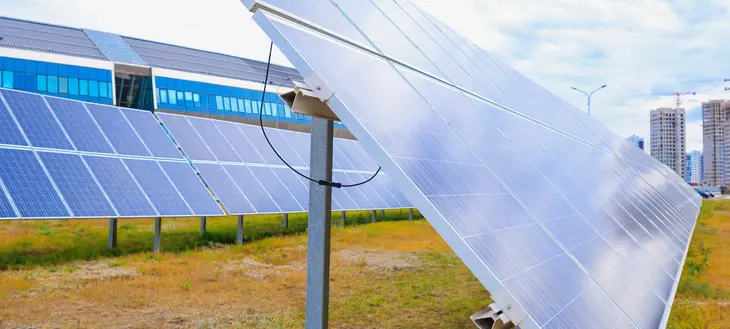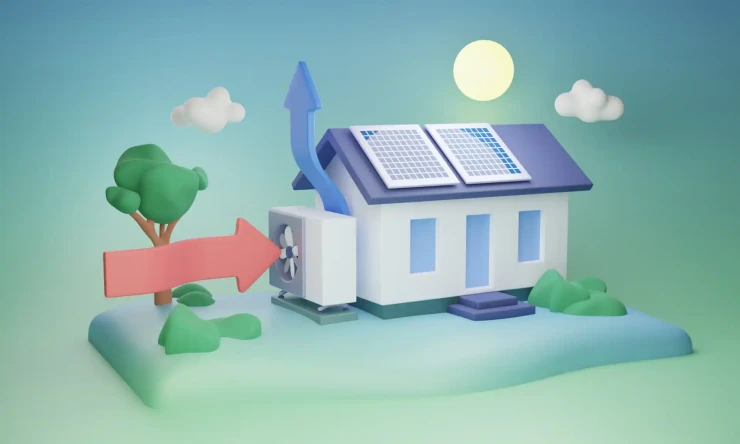
Renewable energy has never been more important than it is today. The energy crisis continues to have an impact on businesses and households in the UK as the cost of electricity remains high. Solar is the fastest growing energy source worldwide, with a global average annual growth rate of 25% over the last 5 years. Solar energy has become increasingly popular in the UK over recent years. The benefits of solar energy have led to increasing numbers of solar installations including solar farms.
Although government policy hasn’t always been clear on solar farms boosting the UK’s solar capabilities is an important part of the country’s energy security strategy. In the past 12 months interest from solar farm operators and landowners has grown as they are look at ways to make better use of under-used sites.
Solar farms have long been a source of controversy in the UK. Many people argue that solar farms will spoil our beautiful British landscape and forget that we have already changed the way our countryside looks with 300 years of traditional farming. Fens, woodland, and other natural habitats have been destroyed to make way for crops to feed our ever-expanding population. To further illustrate this point, the total amount of hedgerows removed or damaged in the last 100 years would circle the earth 6 times. That’s a lot of indigenous species made homeless.
One thing that could help with rewilding, food production, energy generation and the UK’s Net Zero journey is Agrivoltaics which is where solar panels share fields with grazing animals and crops.
The UK is committed to a net zero carbon emission target by 2050. Because solar is a free and renewable source of energy it can play a key role in meeting the UK’s targets for renewable energy and reducing carbon emissions. Solar is even more popular than other sources of renewable energy due to being less noisy and visually disruptive.
COMPARE PRICES FROM LOCAL INSTALLERS
Compare prices from local companies fast & free
Enter your postcode to compare quotes from leading professionals. We promise to keep your information Safe & Secure. Privacy Policy
Just over a year ago the department for Business, Energy, and Industrial Strategy (BEIS) published its energy security strategy which highlighted its support for co-located solar. The strategy encouraged the use of solar panels on agricultural land. The panels would need to be installed in a way that maximised efficiency of land use. Research has shown that agrivoltaic farms can be beneficial for both the land and livestock. There are lots of examples of sheep grazing effectively alongside solar panels, which therefore uses the land to maximum efficiency.
There are definite benefits to agrivoltaic farming that go hand in hand with maximising the efficiency of the solar panels and land use. Solar panels can protect any crops below from hazardous weather conditions such as heavy rainfall and/or heatwaves thus making the crops more productive. Agrivoltaic farming can also reduce water use by lowering evaporation which increases the solar yield by helping regulate the temperature of the solar panels by cooling them down.
It is also worth mentioning here that there are government grant opportunities for landowners and farmers from diversification and the land can be used to its utmost revenue potential.
The Best and Most Versatile Land (BMV) is land that falls within the Agricultural Land Classification (ALC) Grades 1 to 3a. Grade 3b land is land that can produce moderate yields of crops, such as cereals and grass, and a lower yield of a slightly wider range of crops. Currently, Grade 3b land is largely targeted for solar farm development. The development of BMV land for solar photovoltaic (PV) systems, housing, and other uses is highly discouraged.
Despite research showing how farming can work alongside solar panels, the Department for Environment, Food & Rural Affairs (Defra) has been exploring plans to expand the scope of BMV to include middling-to-low category 3b land to protect farmland and enhance food security.
Research from Lancaster university published by trade association, Solar Energy UK has produced evidence that shows that solar farms can enhance biodiversity on farmland.
Solar farms surveyed by ecologists showed an increase in the abundance of wildlife, especially pollinators like bees and butterflies that maintain biodiversity and ecosystem stability. The report said that pollinator habitats, such as wildflower meadows, can be established within solar farms and could increase the abundance of bumblebees by up to four times.
Insects increase food security through the pollination of 84% of crop species in Europe, and the UK including oilseed, strawberries, apples, beans, and tomatoes. The benefit of insect pollination varies between crop types but can increase fruit and seed production, improve quality, and taste, and speed up ripening. Often solar panel installations are perfectly positioned for insects to pollinate nearby crops.
While most people today are familiar with solar farms, agrivoltaic farms differ in that they are designed to promote food production as well as harvesting solar power. The idea being to design an energy system to enhance, or improve, the field that it is used in.
To give an example, if you wanted to grow crops that need shade like Brassicas, carrots and beetroot, a system that provided shade from the sun for a few hours a day would work well. Another example is If you were growing cereal crops you would want to design a solar farm with high frames to keep the panes out of the way of the heavy machinery.
Christophe Dupraz’s research into Land Use Optimization found that the kind of crops you grow can make or break the success of your Agrivoltaic land, and some crops were actually thriving while being under panels.
The panels are important too as studies have looked at how shading affects the crop yields and the benefits of creating a micro-climate due to the panels being above the crops. Once you have understood the PAR, which is the entire visible light spectrum (400–700 nm), and how that would affect different crops and the PV efficiency of the panels, you can start to design your farm and how it will work.
Panels offer shading but also let certain kinds of light through them that can benefit the crops that are growing beneath them. Studies have found that bell peppers increased their yield by up to 3 times to give one example. The research led by Christophe Dupraz indicated that agrivoltaic systems may be indeed very efï¬cient: the increase of global land productivity can be from 35 to 73 percent!
The UK is looking into achieving a five-fold increase in solar by 2035 but if we don’t embrace agrivoltaics we are going to struggle to reach that target. Scientists are currently developing better ways of using AI to track weather patterns, measure and optimise crop growth under panels and even position the panels to protect crops from dangerous weather.
If the world is going to reach net zero, we are going to have to start weening ourselves off fossil fuels. A great way to begin this process would be to mix power generation with food production.
Find a local installer
Welcome to the biggest directory of UK renewable energy companies





























